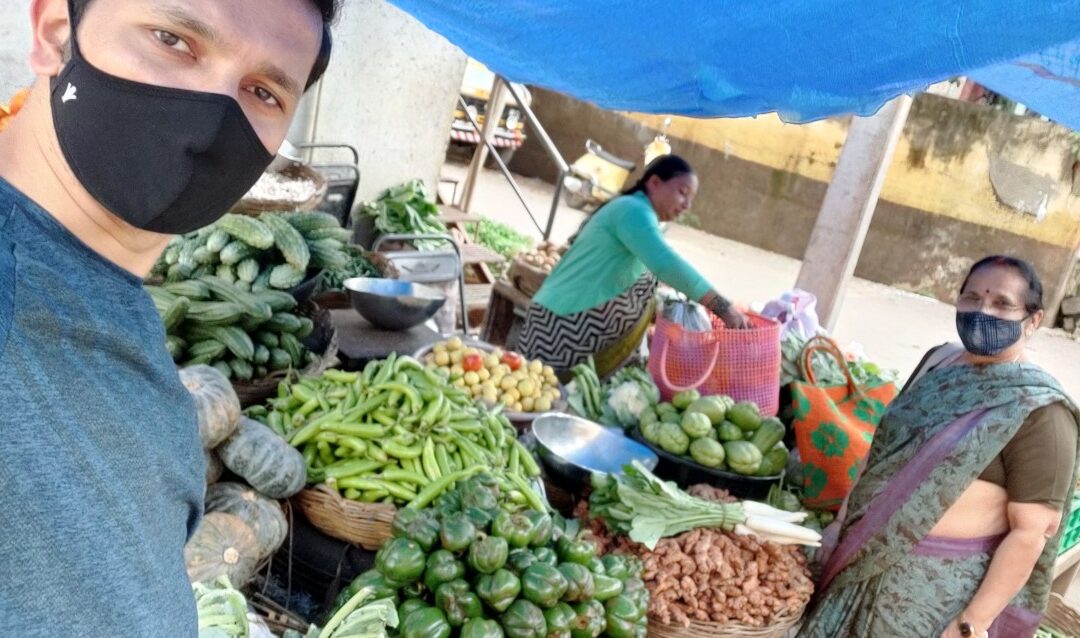What’s plan-B & plan-C
My mother & I started around 8 am to our farm after having breakfast at home.
Mother: Chinmay, before going to the farm let us buy vegetables from Sita’s shop.
Me: ok
(We reached the market and my mother told me where to park the car even though I already knew)
Mother: Take all the carry bags from the back seat as I want to buy more vegetables for the next week.
Me: why?
Mother: because it is Ganesh Chaturthi festival.
Me: Oh… yes, it is next week. I almost forgot.
Mother: Sita, how are you?
Sita: Akka (meaning big sister), by God’s grace, I am fine. how are you Akka?
Mother: I am doing good. Where is your son? Isn’t he helping you today?
Sita: No Akka, today he is at our farm helping his father busier than usual as it is festival next week.
It is good to see your son has come today.
Mother: Yes, our driver who went to his native hasn’t returned yet, so, Chinmay is taking me to our farm.
(My mother & Sita continued their conversation whilst my mother was buying the vegetables)
(Meanwhile, I was just looking around and started thinking about numbers – how much can Sita sell in a day? how much will be the profit margin? How much rent will she be paying? How will she manage the excess stock?)
Sita: Chinmay sir (In India, it is common for shopkeepers to address men as sir), how is your work these days?
Me: Sita aunty (again in India, it is common to call someone around my mother’s age as aunty) it is going well.
How is your business these days?
Sita: By god’s grace it is picking up sir.
Me: I am curious to know how many days will it take for you to sell all these vegetables?
What will you do with the leftovers as most of them are perishable?
Sita: Sir, as I am selling vegetables for many years, I know how much I can sell in a day and accordingly I buy from local farmers.
Me: So, are you going to sell all of these vegetables today itself?
Sita: Yes, most of the perishable stock.
(Me being me, started to consider the worst-case scenario)
Me: Are there days when you cannot sell all the vegetables for some reason?
Sita: Of course, it happens once or twice a week.
Me: In that case, what do you do with the leftovers?
Sita: As I told you that I have been selling vegetables for many years, I have another shop in partnership with my friend. It is just 5 mins from here. Usually, by post-lunch, I will know if I need to send some of the vegetables there.
(again, I was considering the worst-case scenario)
Me: What if in that shop the vegetables are not sold?
Sita: Sir, as I told you that I have been selling vegetables for many years, I know many local hotels, restaurants, and eat-outs. We sell it to them in bulk with a low-profit margin. They are happy to take it and they store it in the fridge that gets consumed over a week.
Me: (now, I wanted to consider the best case scenario) hmm… what if there is a huge demand because of some big festival and for some reason you have less stock?
Sita: Sir, as I have been telling you that I have been selling vegetables for many years, I know many local farmers and also other vegetable vendors who can supply within 15-30 mins with just a phone call.
Me: Sita aunty, please do not mind me asking, I am curious to know did someone teach you or how did you learn about doing this vegetable business?
Sita: When I was young, my mother always said we should aim to sell a minimum of 50% of the goods by noon – then 50% of the remaining 50% by 3pm – and then 50% of the remaining goods before sunset – finally the leftover to be sold in bulk to someone on the way back home or exchange the goods with other vendors who might have leftovers that we might need for our home.
Me: Interesting… that’s a barter system.
Sita: my mother also said not to give more than 20% discount before noon except for regular customers like your mother.
My mother: Chinmay, Sita only gives less than 10% discount to me.
Sita: Akkaaa, no akka, I always give you fresh vegetables at the best price.
Me: ok Sita aunty, did your mother teach you anything about how much stock to buy and store?
Sita: same thing sir, if I have not sold close to 50% by noon then it means I have overestimated, and if I have sold a lot more than 50% then I have underestimated.
As I have been selling vegetables…
(I interrupted and completed the sentence for Sita)
Me: …for many years, I am sure you know what & how much vegetables gets sold.
Sita: (with a big smile) yes sir.
My mother: Ok Sita, we need to go to our farm and go back home for lunch. Let me know how much to pay for all these vegetables?
(Sita started to calculate – I started to keep the vegetables in the car – my mother was taking out cash from her purse – payment was made – then we started to drive to our farm)
Me: Ma, do you know the strategy Sita’s mother has taught her is similar to the one used in the fashion industry?
Mother: Really?
Me: yes,
for example: when a fashion brand that sells T-shirts orders for 1000 pieces of T-shirts they sell the first lot (say 200) at a very high margin without giving much (less than 10%) discount during the first week or so – then another 200 to 300 T-shirts will be sold by giving 10 – 20% discount.
By selling nearly 50% of the stock they would have hit the break-even point and made some marginal profit. With the remaining 50% of the T-shirts, they bundle with new stock (buy 1 get 1 free offer) or give heavy discounts (over 50%) or sell to another vendor in bulk or so on.
The industry might be different with different timelines but the strategy is the same.
Mother: same strategy?
Me: yes, they have plan-B and plan-C to sell all the stocks, in other words, they have different target markets to sell at different locations/times with different prices & offers.
The big companies use sophisticated software to do a lot of analysis & research to track the market trend with so-called highly educated professionals before making decisions with regards to how much to order – how much to stock – at what price to sell at different times?
With Sita aunty, decisions are made using her ‘unconscious competence’. In other words, as she has been selling…
(this time my mother completed the sentence with a little laughter)
Mother: … selling the vegetables for many years Sita knows to a great extent how much to order – how much to stock – at what price to sell at different times?
…………………………………………………………………………………..
Is your business B2B or B2C or B2G (Business – Consumer – Government)?
If B2B, is your top customer giving more than 70-80% sales?
If B2C, is one target market giving more than 70-80% sales?
If B2G, is one big contract giving more than 70-80% sales?
If yes, or kind of yes, then what-if for some reason it gets stopped/canceled/discontinued?
Do you have plan-B? plan-C?
PS: there are 23 more alphabets that can be used 😉
#planb #businessstrategy #financemanagement #bottomline #financeacademy

